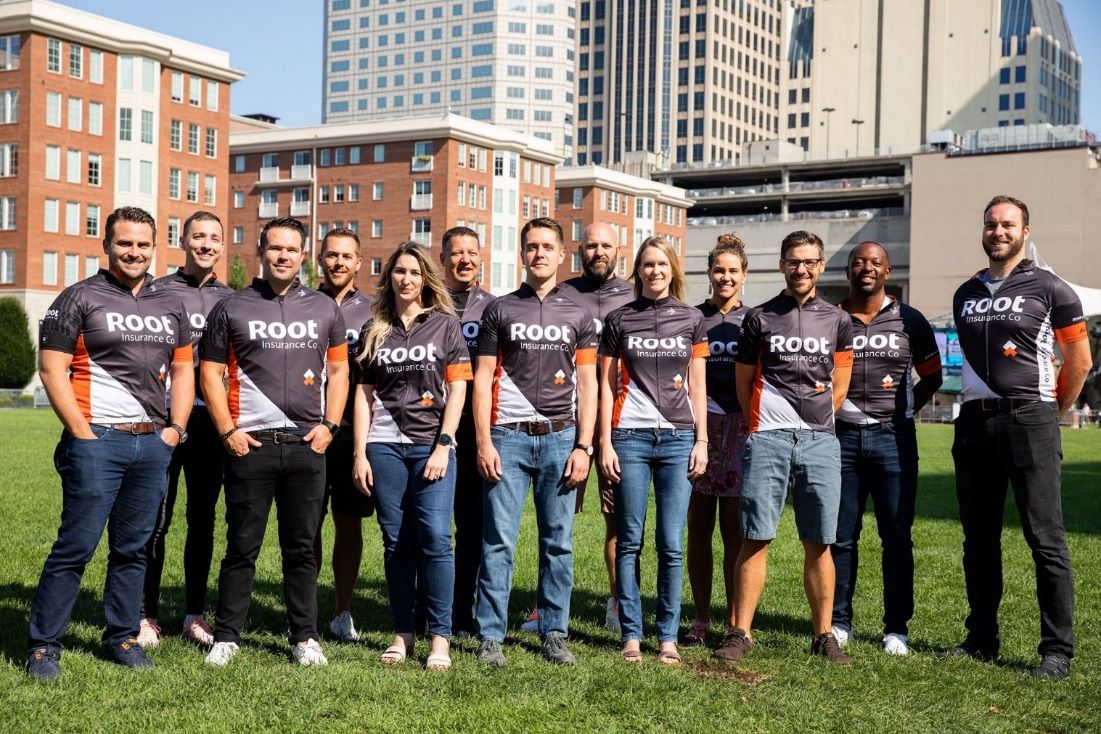How Root Actualizes Insurers’ Technology Dreams & Takes Insurance to New Heights
Based in Columbus, Ohio, Root Insurance Company runs a mobile software evaluating driving behavior using smartphone technology, telematics, and data analytics before determining a final tariff. Founded in 2015, recently, Root has expanded into its 29th state, which makes it available to more than 65 percent of all drivers in the United States.
Before got those impressive achievement, as other startup, Root also experienced challenges at first stage. Let’s take a look back at this company’s arduous journey to explore how it has extended its scale.
The Very First Triumph
“While technology has radically changed our lives, in many ways the insurance industry still operates as it did a century ago,” said Alex Timm, the company’s CEO and co-founder. “The industry continues to principally rely on archaic variables that do not measure driving behavior and are unfair to consumers.”
This idea of the co-founder set the foundation to Root’s release. Root was the first vehicle insurance company in the United States to be formed on the ideals of justice. Its platform is seamlessly controlled through a first-of-its-kind mobile app that utilizes smartphone technology and data science, allowing the firms to ensure users based on how they actually drive – not just their demographics. Root is also genuinely concerned about safe driving, and it rewards safe drivers with significant savings.
After 3 years developed, the firm announced the conclusion of a $51 million Series C fundraising round in April 2018, making it one of the largest funding rounds reported by an Ohio tech startup. In the first six months of 2019, the firm wrote more than $187 million in insurance premiums, an increase of 824 percent over the same time in 2018. Those incredible numbers that Root got was believed to be partly contributed by its headquarters state.
“Root’s growth since we were founded in 2015 is due in no small part to the strong talent we continue to find in Columbus,” said Alex Timm. “While this expansion will allow us to continue to grow Root’s offering nationally, it will also deepen our roots in Columbus, with the resources and space to grow the business with the momentum it deserves.”
Why Columbus?
This company evaluated multiple markets in the Midwest and East Coast carefully before making the decision to further expand our Columbus-based operations.
“The Columbus Region has long been home to leading insurance brands, and Root is proof it will be home to leading insurance brands in the future,” said Kenny McDonald, president and CEO, Columbus 2020.
The Columbus State is on track to enjoy its most prosperous decade in history. Recently, it continued to pursue its objective of creating opportunity and building capacity for economic growth across the 11 Columbus Region counties, with the help of private organizations, community, and public-sector partners. Root was one of them.
“Root’s expansion is an example of how innovative companies can effectively start and scale their operations in the Columbus Region,” said Columbus Mayor Andrew J. Ginther. “The company’s continued investment and rapid expansion in Columbus has added to our business community immensely, and we look forward to helping them achieve ongoing success.”
It means, their relationship is win-win one. On the one hand, Root’s expansion helps Columbus achieve this state’s 150,000 net new employment 2020 Regional Growth Strategy target. On the other hand, the expansion is conditional on City of Columbus incentives being approved. Jobs Ohio plans to assist with the project as well.

“It is no surprise that Root Insurance advanced a new approach to serving its customers from its operations in the Columbus Region,” said Jobs Ohio Managing Director for Financial Services Valentina Isakina. “The region’s cluster of insurtech talent makes it an ideal location for innovators like Root to succeed, and we are delighted its growth will bring 400 new jobs to downtown Columbus.”
Not only did Root contributed to solve Columbus’s employment problem, but it also helps increase the security there by rating drivers’ behaviors before underwriting the insurance. The more careful they drive, the more benefits they get.
Consumers who are interested in Root coverage must first download the Root app and complete a “test drive,” which lasts two to four weeks and requires customers to drive their automobiles normally. Customers’ smartphone sensors and Root’s algorithm will pick up their driving patterns during the test drive, which will eventually underwrite the insurance. Furthermore, Root follows the 80/20 rule by excluding the riskiest 10-15% of drivers from coverage based on their test drives, a group that accounts for the majority of overall accidents.
Simply said, Root promotes safe driving behavior by providing better pricing to safe drivers, as opposed to traditional insurers’ pooled-risk pricing model, which takes a more uniform picture of risk without segmenting good and poor drivers.
This model seemed potential. However, despite its intriguing pricing strategy and the social good it generates, the markets appear to have overlooked its potential. It punished the company, which has fallen from its IPO price of $27 to $8.50 in 2020. The sell-off has even caught the attention of infamous short-seller Andrew Left, who published a long call for Root. This is a company backed by well-known investors such as Redpoint, Ribbit Capital, and Tiger Global Management, and the sell-off has even caught the attention of infamous short-seller Andrew Left, who published a long call for Root.
Building-up Losses
The whole picture is even a chain of losses, though. In 2018, the firm lost $69.1 million, $282.4 million in 2019, and $144.5 million in the first half of 2020.
Root, like many other new fast-growing digital businesses, stated in its regulatory filing that it does not anticipate its losses to stop anytime soon. According to its report, incidents involving the company’s clients were a major cause of losses.

According to the firm, rates must be enough to produce income to cover losses. However, the business stated that it must continue to spend in technology, core insurance operations, and expansion, as well as other expenses. Meanwhile, traditional insurers are putting a lot of pressure on Root.
“We put pricing accuracy in the forefront of our business. Over the long term, prioritizing underwriting and pricing accuracy will lead to superior performance.” – said Timm.
Nonetheless, the firm believes its tailored digital approach to covering drivers based on how they drive, rather than more traditional measures such as credit scores, education, and marriage, is poised to disrupt the $266 billion auto insurance industry.
How Can Root Keep It Business?
There are no agencies to build, and no mountains of paper to push. What is the secret of Root to keep its business?
#1. Labor Resource Orientation
By developing a labor resource with rational rate and clear technological orientation, Root was able to expand dramatically. According to Dan Manges, co-founder, and chief technology officer at Root, engineers make up about a quarter of the 140 workers at this company.
“The ability to grow the company with software and technology is a huge factor for us,” he said. “It’s what allows us to scale so rapidly.”
Root used a great amount of its fundraising to employ more engineers and data scientists, as well as traditional actuaries, claims adjusters, and customer service personnel. “We’re in 20 states and our team is working relentlessly hard at expanding into the remaining 30,” Manges said.
In fact, days before its first statewide running, this company were able to have 97 percent of the workforce, including its Customer Service and Claims teams, which is up and functioning remotely in less than 24 hours. By this way, Root ensured that its clients were not inconvenienced by higher wait times on calls or for claims during the work from home period.
Besides, Root also has a distinctive procedure. Instead of shutting down the program for routine maintenance, Root’s team works in tiny iterations, upgrading cloud-based software daily and providing mobile app updates weekly. When it enters a new state, this, combined with the flexibility of Amazon Web Services cloud computing and storage, allows for “effortless” expansion.
According to CEO Timm, the firm was founded on grit and drive. But, as we have seen, it has grown into something more. The company was created for diligent and determined people as well as smart operation.
“There’s a lot of people really attracted to the type of opportunity we have at Root to build a transformative product in an area that affects almost everyone in the country.” – said Manges.

#2. Flexible Workspace
Root is a cloud-based company that creates mobile-based services. That is why it intended to be mobile from the beginning.
On their first day at Root, all Root workers are given a laptop (not a desktop) along with all the necessary accessories to execute their jobs successfully. Because its call center is entirely VOIP-based, there are no physical phones on any of its workstations.
What does it mean? It means that Root’s personnel may provide world-class customer service from home just as easily as they do from their offices with a laptop and a USB headset.
In fact, no one protested when it became obvious that Root would have to contemplate sending its 850+ workers home to work remotely. Root has maintained its commitment to continuous development as it has developed. Root workers in every department began gathering information and suggestions on best practices for remote collaboration as soon as talks about working remotely began.
Root’s IT infrastructure is also adaptable. This company use the cloud for all of its software and data. It does not keep that information in its offices only. By this way, Root guarantees client data is secure by providing rigorous access controls on all of its cloud products, while also allowing all of its workers to work from home in a manner similar to that of a Root office.
“People thrive on connection, and for many of us, transitioning away from the day-to-day contacts we’re used to at work has been challenging. Many of my new coworkers have yet to meet me in person. But it gives me some peace of mind to know that we’re all in this together, and we’ll keep doing what’s best for each other, our communities, and our consumers. And as a result, we’ll be closer and a lot stronger company at the end of this.” – said Timm.
#3. Cooperation with Local
To fulfill the standards of each state, the app must be modified, and the business collaborates closely with state authorities. That’s why on March 8, 2019, Root Insurance announced Dave Luketic will take responsibility for the Director of Government Affairs for this company. In this role, Luketic will be responsible for the strategic direction and management of the company’s government relationships, including political affairs and public policy with U.S. federal, state, and local governments; as well as developing grassroot advocacy campaigns.

“We want to work hand in hand with these departments, so they know what we’re doing,” Manges said.
In fact, by keeping on well with local, Root can not only have timely adjustments o their app based on state’s law but also get approach to the state’s support.
“It’s important to the health and vitality of the City that we support homegrown businesses like Root Insurance that are growing and looking to expand,” said Councilmember Emmanuel V. Remy. “We want to prioritize companies that value living wage jobs and are committed to the City of Columbus. I am excited to witness their future success.”
The Bottom Lines
Root’s success continues to attract leading investors who recognize the impact Root has already had on the industry and the opportunity still ahead. Of course, its future development is still based on other factors.








